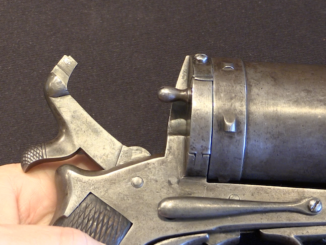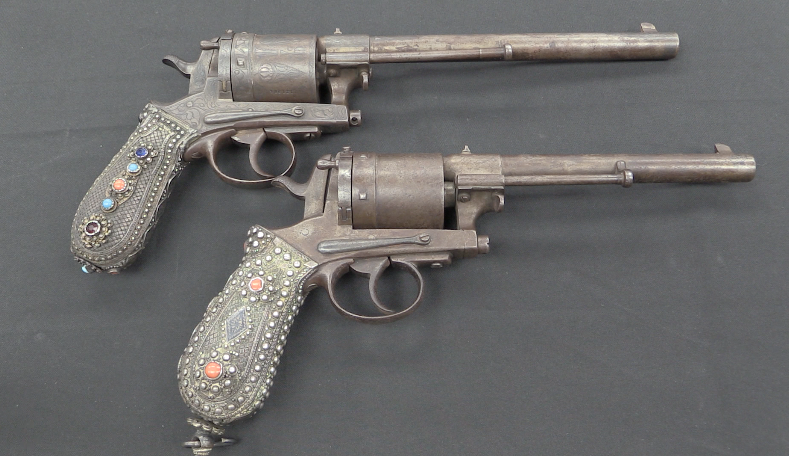Tara Aerospace is an arms factory in Montenegro that was privatized around 2013 or 2014, and a major stake in it was purchased by one Heinrich Thomet (formerly of Brugger & Thomet, and then the basis for a character in “War Dogs”). The first firearm the new Tara produced was the TM-9, and it was not very good.
The basic design concept is fine – it’s a modern style of service pistol; polymer-framed, striker-fired, and chambered for 9x19mm. It has interchangeable grip backstraps and a rail for a light (no optics cut; it was too early for that). Where it differs most obviously from other options is the use of a true double-action-only trigger. The striker is fully forward at rest, and the trigger pull is responsible for fully cocking and then releasing it. This makes for a very long and heavy trigger, but it also simplifies the trigger mechanics and obviates the need for a manual or trigger safety.
The first production of TM-9 pistols was not of particularly good quality, but the factory needed money and so a batch was sold to a European distributor. They were not intended to end up in the US, but did end up purchased by Century, who brought them into the country and then discovered that they basically didn’t run reliably. Slides not going fully into battery was a major issue in particular. While trying to figure out how to deal with this, Century secured a deal to sell them all to Gander Outdoors, which planned to have them all overhauled by America’s Gunsmith Shop. Before that was completed, though, Gander decided to just abandon gun sales entirely and sold the guns back to Century as a loss.
Some began to get out onto the market, and American buyers were pretty annoyed at the reliability problems (not that you would know it form the generally-positive reviews in the gun press at the time). Having never intended the guns to get to the US, Tara’s answer was to declare that the early production guns were actually only intended for use with “rubber bullets” and were never supposed to be sold as live guns at all (https://www.tara-arms.com/pdf/tara-arms_tm9-gen-1-rubber-bullet-use-only.pdf). The gun in this video is specifically listed in their warning by serial number, by the way.
Eventually, Century sold the remaining TM-9s to Centerfire Systems, who is now blowing them out pretty cheaply, with full visibility of this backstory (for the record, I acquired this one before the sale to Centerfire). Tara, meanwhile, is trying to sell their newer and presumably better model to Century, who so far refuses to buy any until the “rubber bullet” warning nonsense is removed form Tara’s web site.



I have to say the Brazilians are ahead of the Montenegrins.
Sorry Ian…
But…
You should read the manual first…
Most important feature of “Tara” pistols is… Its trigger action… “Double Action Short Reset”… It means… In successive shots… If shooter keeps the the trigger pressed and lets released forward under trigger finger pressure for a short distance… The action will reset without needing to release the trigger fully forward… Very fast successive shots can be done through this action…
Trigger mechanism is fully copied from “Glock”including “Connector/Disconnector” with a difference that its trigger goes more forward… Trigger reset mechanism is same…
Yep, not “a lot fewer parts” than a Glock. Same cheap plastic or stamping trigger, trigger bar with cruciform sear area, and [slightly different] mechanism for guiding the bar down and off the striker hook.
https://www.firearmsnews.com/editorial/lightning-tap-double-action-trigger-glocks/453104
Makes purchasing a Hi-Point an upgrade due to reliability issues with the Tara.
Elbonian Olympic Shooting Team ?
I’m pretty sure looking at how the trigger mechanism is sent up that as the slide is going into battery the firing pin block is getting caught on the the trigger bar.
If you look closely at the angled surface of the firing pin block lifter on the trigger bar it appears to a bit of peening, I’m pretty sure if you dressed that angled surface up with a file that gun would go into battery reliably.
But at that point unless that’s an inertial firing pin you might be popping off rounds as it goes into battery.
I think that the poor quality control might be the only thing keeping that design safe.
Oil, oil, oil. Then more oil. Get a quart of cheap 40w.
The “rubber bullet” excuse tells me nobody at that end knew much about recoil-operated systems. Rubber is less dense than lead or etc., so unless you somehow get the projectile up to an insanely high muzzle velocity, recoil impulse will be much lower, which itself will contribute to malfunctions.
(The travails of the Glock 9mm with 147-grain subsonic HP in police service in the U.S. is another example of this malady.)
About the only effective way to deliver a “rubber bullet” is either as a “stingball” load of pellets (usually about 00 buck size) for a shotgun or GL, or if you are absolutely determined to deliver it as a single bullet, an AR-15 upper in one of the heavy calibers such as .45 SOCOM or .50 Beowulf.
Note that you almost certainly will need one modified to either straight blowback or some sort of manual pump-action, which of course can cause all sorts of problems if a round of full-power ammunition gets in.
Best advice? Stick to 12-gauge. A Remington 870 won’t care whether the shot in the power piston is lead or Mini Super-Balls (TM).
clear ether
eon
Very well said, and that would have been an excellent ending for the video:
“Since this fails to cycle about 10% of the time with standard 9mm ball, Tara adopted the ploy of claiming it’s meant for rubber bullets – which, as we can see, fail to cycle 100% of the time.”
“(…)“rubber bullet” excuse tells me nobody at that end knew much about recoil-operated systems. (…)”
Their cover story that Many of them were sold as blank firing pistols but then brought to the market as real guns.(…)Only rubber bullet ammunition should be used with these pistols. looks not well-though for me. 1st part suggest they made them to fire only blank cartridge, which generally do not have any bullet at all, then they are made for rubber bullet.
“(…)only effective way to deliver a “rubber bullet” is either as a “stingball” load of pellets (usually about 00 buck size) for a shotgun or GL(…)”
If these weapon are too typical for your tastes, you might consider something akin to https://www.popularmechanics.com/military/weapons/a18812/pogojet-non-lethal-gun/
Captive-piston rounds are nothing new;
https://apps.dtic.mil/sti/pdfs/AD0864423.pdf
Later, the “piston” round was replaced by a special subsonic .44 round with a flat-nosed lead bullet (just within the parameters of the Hague Accord). It presaged modern “medium velocity” lead-bullet Magnum ammunition.
The problem with such ammunition isn’t its range, which is largely irrelevant at the distances usual for CQB. The problem is low reliability and high environmental sensitivity.
I would expect this example to have substantially lower reliability and higher environmental sensitivity than a modified S&W revolver.
cheers
eon
Montenegro is just like Serbia, only more so
Iirc 40% of population are Serbs by professed nationality.
If they stayed in union with them, it would have been like 70-80% in 50 years, imo.
This pistol is comically bad, and yet it is so simple that I feel that it must be capable of improvement. There is no reason why it has to be so bad, but the Montenegrins found a way to do it.
I suspect the problem is in this pushing sear that is not falling far enough down, when in recoil slide returns, so underside of firing pin catches on it and blocks the full return. Maybe a stronger recoil spring would also help.
As for crappy shooting working, there is a phenomenon of dithering, discovered in ww2 that some mechanical computers worked better loaded aboard plane in flight, than when stationed on the ground with zero vibrations.
Btw. in first shooting, Ian has croatian army digital camo,and a flag on gray cap.